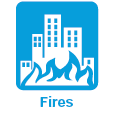Microsoft ends support for Internet Explorer on June 16, 2022.
We recommend using one of the browsers listed below.
- Microsoft Edge(Latest version)
- Mozilla Firefox(Latest version)
- Google Chrome(Latest version)
- Apple Safari(Latest version)
Please contact your browser provider for download and installation instructions.
Improving Network Reliability
We endeavor to build disaster-resistant communications networks, facilities, and equipment.
Disaster-resistant communications networks
Curbing the impact of damage to transmission lines
Trunk line multi-routing
The key to constructing networks that keep people connected is to design for continuity of communication services by making connections robust enough to withstand disruption and ensure that they can be quickly restored even if disrupted. Trunk line multi-routing is one way of achieving this aim. Our nationwide network of trunk lines has been designed to secure communication and prevent disruption of services over the network as a whole by automatically diverting transmission through other routes when a certain route is damaged.
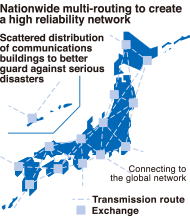
Curbing the impact of cable breakages
Submarine cables designed to withstand disasters
We have laid a high reliability, low latency submarine cable (ASE*) that not only links Japan with Hong Kong and Singapore by the shortest possible route, but also avoids the Bashi Channel off the southern coast of Taiwan, a zone that is susceptible to earthquakes, typhoons, and other natural disasters.
*ASE:Asia Submarine Express

Curbing the impact of damage to communications buildings
Distributed location of important communications buildings
If communication buildings (important communication buildings) fitted with transit switches suffer disaster damage, all communications via such buildings may be severed. Distributing important communications buildings in different locations helps avoid the risk of multiple buildings suffering disaster damage at the same time.
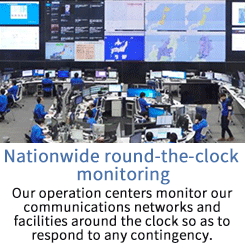
Disaster-resistant communications facilities and equipment
Withstanding strong typhoons and preventing inundation by tsunamis or floods
NTT's communications buildings and steel towers are designed to withstand strong typhoons with gusts of 60 m/s. Our facilities are also equipped with flood barriers or flood doors according to location to prevent inundation by tsunamis or floods, and cable connections are also waterproofed.
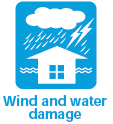

Designed to withstand Shindo 7 earthquakes
NTT's communications buildings and steel towers are designed to withstand earthquakes of a seismic intensity of 7 on Japan's Shindo scale. The switching, electrical, and other communications equipment housed in our communications buildings is also firmly secured to prevent its collapse.
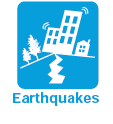
Backup power to guard against grid power outages
Our communications buildings and wireless base stations are equipped with backup power sources(batteries, generators) to keep them running for extended periods in the event of sudden power outages. We also have power supply vehicles stationed around the country to substitute for backup power sources that look likely to cease functioning.
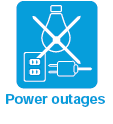
Fire prevention and fire proofing
We equip our communications equipment rooms with fire doors or shutters, and connections between communications buildings and cable tunnels with firewalls and fire doors. We guard against the outbreak of fires within our communications buildings by equipping them with smoke detectors and fire extinguishing equipment. We also use flameproof communications cables.
